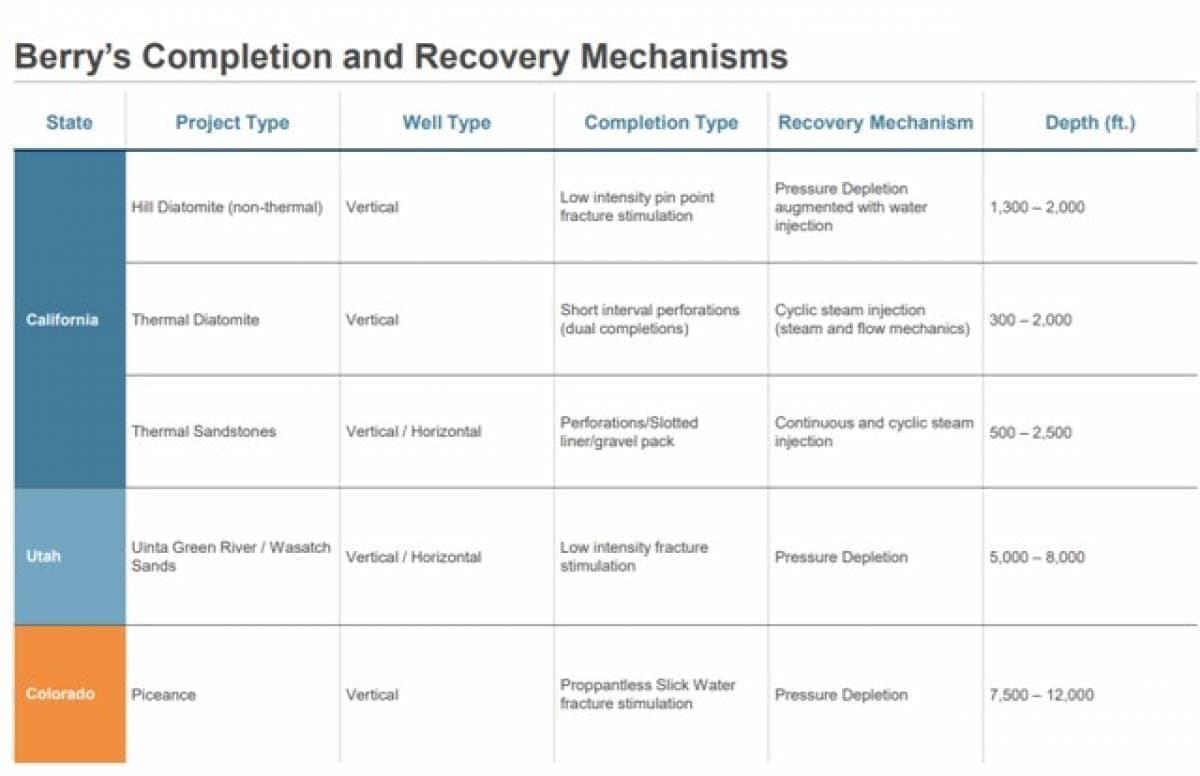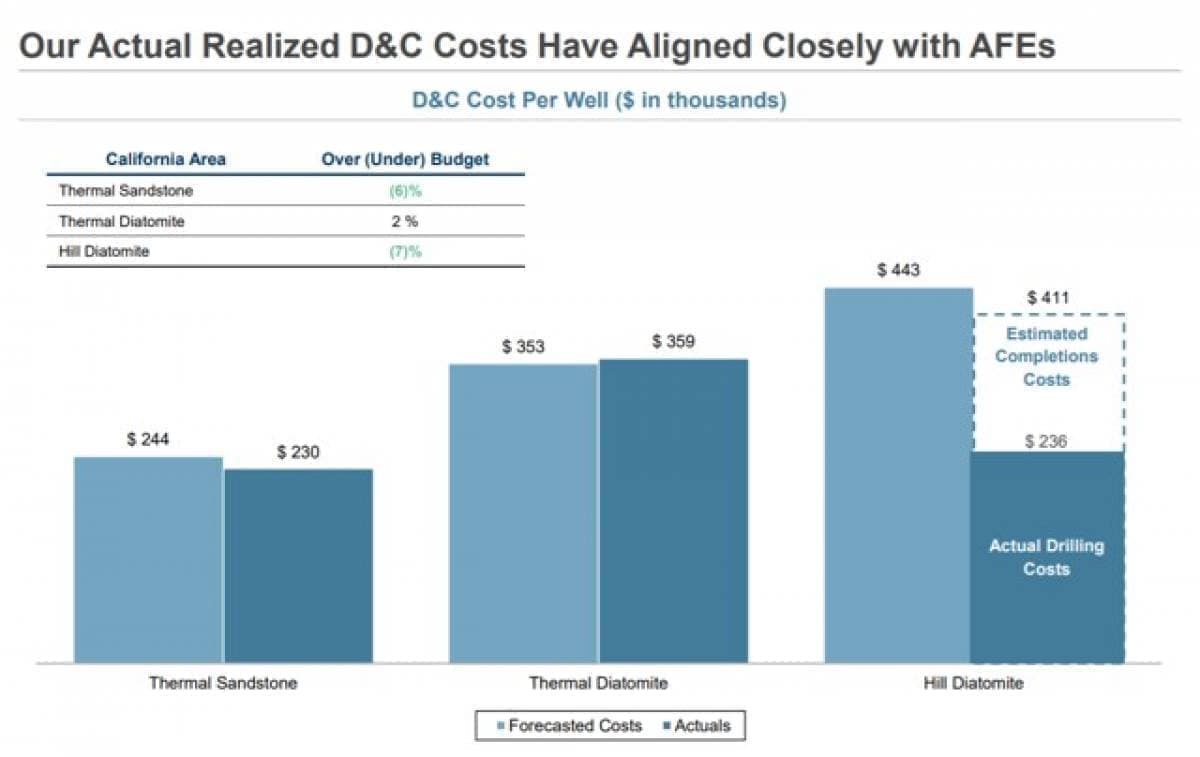Berry Petroleum, (NYSE:BRY) has just emerged from a period where they were acquired for $2.5 billion by a large independent, Linn Energy- which went bankrupt in 2016, thanks largely to the debt taken on in that transaction. In 2018 with new management, they re-entered the capital market with a midyear IPO.
It’s been a tough market since then, and Berry currently stands at a ~40% discount to its $14.00 IPO price. Most of the decline has come in the last couple of months, where oil related issues have lost favor. Their first quarter results of $-0.42 EPS haven’t helped either, particularly when compared with their Q-4, 2018 results of $1.52 per share. That all taken into account, we think it is oversold currently and represents an exceptional value at these levels.
Berry’s operations
Berry's assets are geared to conventional, well understood plays, as a contrast to the ubiquitous shale story, that now has a wart or two (at least temporarily) on it. As a California producer they have a dedicated market in the 'Golden State, with little fear of outside competition from the east.

They are primarily heavy 13 API gravity, black oil producers with assets focused in two main areas, Kern County's San Joachim basin, and the Uinta basin in Utah. Most of their production (87%) though is right in California giving them a dedicated market with few competitors. Related: Oilfield Services Feel The Pain As Crude Prices Drop
With their current asset base they have a couple of decades of drilling opportunities ahead of them. The key to the Berry story is the type of wells they drill and their low costs to produce them. Their typical well is only a couple of thousand feet deep, and they aren't putting a $5 million frac on them to get the oil out. Costs for these wells run from $.5 million to $1.2 million, far below the typical $5-6 million shale wells require to drill and complete.
The bulk of Berry's assets are in California in the San Joaquin "Super Basin"

This is an area I know well. It is covered with hundreds of thousands of oil wells of the type you see in the inset picture. There is massive infrastructure to develop new wells in this basin.

We'll focus on these as they form the cornerstone thesis for this company. I view the Uinta, and Piceance basins as being 'gravy' to the overall story.
Given their long history operating in this area, Berry understands their reservoirs at a high level. Instead of blindly fracking these wells, Berry has determined the optimum stages, and low intensity sand concentrations to frac what matters! They refer to these as 'pinpoint' fracs, and installing completions with this mindset enables Berry to keep costs down.
On the thermal sandstone field they have determined that a matrix gravel pack (pumped below frac gradient is superior to fracking. Gravel packs are generally much cheaper than fracs, as they use far less material and take less time and horsepower to pump.

Note the depth from which most production in California is obtained. These are relative 'post holes' compared with the 'miles' of reservoir the shale frackers must drill to get their payouts.

Kern County, California is the steam-flood capital of the world. If you have never been out there, it's kind of an ugly sight...until you realize how much money is being made. I suppose it's still an ugly sight, but if you have 'skin', perhaps you can metabolize it better.
Steam heating reduces the viscosity of the oil, enabling it to flow toward the well bore.

Source A picture of a Kern county steam flood. Not visually the oil industry's best ambassador, perhaps.

The wells cost just a few hundred thousand dollars to drill and complete. Their daily production is small, but it can go on for years.

The decline curves shown by Berry in the slide above for their low cost production in the San Joachim versus several of the big frac plays in the NA shale basins.
The curve for the sandstone formations is impressive and has to do with the enhanced oil recovery technique of steam flooding (EOR). Bottom line these wells will still be producing years, after they have repaid their capital costs.

Access to markets, or lack of is a big story impacting some unconventional producers. A story that is hobbling growth for some companies in the Permian at this time, as an example. Berry takes pains to point out this is not a problem for them. California is well covered by north/south pipe line infrastructure that leads to massive refineries in the San Francisco and LA areas.
Financial performance in Q-1
We have discussed their low capital costs per well, and the comparative longevity of Berry's wells once they are on line. Financial management is the next area of performance.
Revenue and Margins. In Q-1 revenue was down YoY by 8% at $131 million, while being down 12% QoQ. This was primarily due to lower realizations on stable YoY production. Margins fell due to increases in spot gas prices, ~$4.00, this winter that is used to generate electricity in their steam generators. They have put hedges on for the next 18 months that will keep this cost below $3.00 mmbtu for that period.
Debt. Long term debt stands at $391 million in a $750 million credit facility that matures in 2026. Debt repayments are made semi-annually and are covered by EBIDTA. Berry’s CFO, Cary Baetz comments-
“Our adjusted EBITDA of $54 million covered our capital expenditures of $49 million as well as our financial obligations, including interest and dividends. In other words, we operated within levered free cash flow.”
ADVERTISEMENT
Production.

Note-Comparisons to prior years are difficult due the company having just emerged from the Linn Energy bankruptcy. At the low end of the forecast above, Berry will generate annual revenue of ~$685 million over the year and generate EBIDTA of ~$280 million. With Capex steady at ~ 200 million, ample money will be available for funding the (currently yielding 4.64%) dividend at ~$48 million and share repurchases of ~$25 million per quarter.
Risks
In my opening paragraph I referred to exogenous events that had no real bearing on the business model. One of them is California, AB-345, which some headlines had as a death knell for the oil industry in the state. Like all eye-catching headlines when you unpack it, things are just not that bad. Berry estimates that only 4% of their California production would be impacted by this measure, if it were to be enacted. At the present time, that’s a big if. AB-345 is stalled in the appropriations committee with no exit likely as opposition builds.
Still as Berry’s CEO Trem Smith noted in the Q-1 Conference Call-
”This is good news, but we must and will continue to monitor the bill's status and continue to work with industry partners, local governments and trade associations, utilizing our Berry First approach to inform and educate constituents, legislators and stakeholders on the impact of this bill and several others.” Related: Is There Really An Oil Shortage?
I think the risk that politics imposes on this company, while real, is manageable. To assist in engaging with local and state governments Berry has created a new Vice President for Regulatory Affairs position, and hired an experienced executive, Megan Silva, to fill it. This is a good step as you can’t hide from regulators. It’s much better to engage with them to shape outcomes. Some might call this lobbying, but communication is always key to success.
There is always the oil price risk, but Berry will have 50% of their 2020 daily production hedged at $67.11, moderating price fluctuation risk.
Your takeaway
As discussed Berry's price has been hammered by what I will call exogenous events that have no bearing on their business model. With an EV/EBIDTA of 4.83 they are currently in an acceptable range that should only improve going forward.
At their current price of $10.34/sh, Berry is selling for less the 7X forward earnings. With the remaining balance on their credit facility plus cash they have liquidity of ~$400 million and face no current solvency issues.
All in all, I think this is a company in a good position to grow earnings and profits going forward. I believe as the company executes on their plan the market will expand this multiple generously. As an example some Permian names, Apache, NYSE: APA, and Devon, NYSE: DVN carry multiples between 14 and 25 X earnings. A multiple expansion of 30% for Berry would yield a stock price of $14-15/share, and I think is within reach as they deliver over the next couple of quarters.
In summary, Berry is getting no credit from the market for their “moat” in the California market, or the low decline of their reserves. This should soon correct.
By David Messler for Oilprice.com
More Top Reads From Oilprice.com:
- Oil Is On The Brink Of A Bear Market
- Oil Falls After Sharp Rise In Crude, Gasoline Inventories
- Battery Breakthrough Solves Major Electric Car Problem



















1. substantially lower its EOR costs: after a ~4 year payback period, it would have very cheap steam for EOR (~$0.40/mmbtu gas price equivalent for 30+ years).
2. this steam is all zero-carbon, so Berry would dramatically lower its emissions, remove a huge carbon bulls-eye from its back, and be top in its peer group with CSR / impact investors.
3. generate >100,000 LCFS credits per year which are trading ~$190 . . . i.e. $19 million per year additional potential income from credit sales.
3rd-party project finance is available, so let's hope the they pursue it.